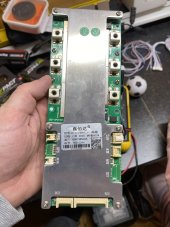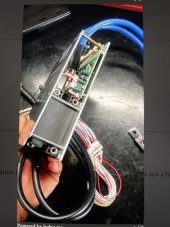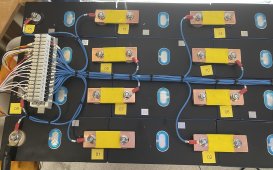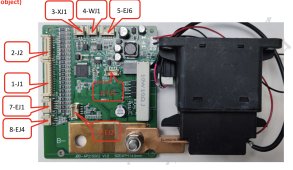I joined this forum a year ago and shortly afterwards purchased from a fellow forum member the following items:
Around that time British Gas had been hounding me to have a Smart Meter installed, so I signed up for the smart meter thinking I can subscribe to a cheap rate night tariff. 14 days later I had the smart meter installed and I immediately “switched” to Octopus who have a much better choice of tariffs (another 7 days). I then had Octopus move me to the Economy 7 tariff which was another few weeks. Final after nearly two months with little sun or battery power I was able to charge the batteries overnight on cheap rate electricity from the grid. However, this did not cover all my usage and some days I had to utilise the more expensive day time rate but still I halved my electricity bill.
Previously I had directed a couple of friends to Docan as the batteries they supplied are quality and they also have a good name here. So, I placed an order with Docan for the same items one friend had recently purchased from them: 16x CATL Lifepo4, busbars & nuts, 2x JBD 200A Smart BMS with BT & RS485 (one for existing batteries), trade assurance, so what can go wrong!
Delivery was earlier this month and a few weeks before I expected which was good. On opening the wonderfully packaged batteries I could see they all were flat and good quality but what where these BMS’s they have a Relay, really?
I’ve not seen BMS’s with relays for some time and expected a MOSFET BMS as all others are and the same as what my friend had received. I then queried Docan why I had received these who said I didn’t ask, and these are cheaper! Did I really need to ask, who would think they are providing old technology and cheaper what $2 cheaper, really? This went back and forth getting nowhere and clearly Docan would not have them back or refund me. Best they could do was give me $32 each off if I ordered again, so would cost me another $260 to get what I had original thought I would get. I mentioned about going through the trade assurance route and Docan said they would do nothing. I filed a dispute and trade assurance gave me back $150 so half of the originally estimated cost.
As I only had these bricks of a BMS, I built the new pack on the bench with one. The BMS seemed OK and I was able to bring this new battery pack online in parallel with the first pack which has a JBD Smart BMS 100A (MOSFET). I ran both for a day or two and decided to rebuild the first pack with the 2nd brick of a BMS but it was very tight in the Powerwall cabinet. On bringing both packs back online with the Relay brick of BMS’s it was clear they don’t like each other as I could only get one working at a time. I did manage to get both online at the same time by powering everything off but after a charge only one would start discharging. At this point I immediately ordered a JK BMS and the Relay BMS’s are going.
What have I learned:
Vince
- 16 x 280ah Docan batteries
- Victron 48v inverter
- JBD 100a BMS
Around that time British Gas had been hounding me to have a Smart Meter installed, so I signed up for the smart meter thinking I can subscribe to a cheap rate night tariff. 14 days later I had the smart meter installed and I immediately “switched” to Octopus who have a much better choice of tariffs (another 7 days). I then had Octopus move me to the Economy 7 tariff which was another few weeks. Final after nearly two months with little sun or battery power I was able to charge the batteries overnight on cheap rate electricity from the grid. However, this did not cover all my usage and some days I had to utilise the more expensive day time rate but still I halved my electricity bill.
Previously I had directed a couple of friends to Docan as the batteries they supplied are quality and they also have a good name here. So, I placed an order with Docan for the same items one friend had recently purchased from them: 16x CATL Lifepo4, busbars & nuts, 2x JBD 200A Smart BMS with BT & RS485 (one for existing batteries), trade assurance, so what can go wrong!
Delivery was earlier this month and a few weeks before I expected which was good. On opening the wonderfully packaged batteries I could see they all were flat and good quality but what where these BMS’s they have a Relay, really?
I’ve not seen BMS’s with relays for some time and expected a MOSFET BMS as all others are and the same as what my friend had received. I then queried Docan why I had received these who said I didn’t ask, and these are cheaper! Did I really need to ask, who would think they are providing old technology and cheaper what $2 cheaper, really? This went back and forth getting nowhere and clearly Docan would not have them back or refund me. Best they could do was give me $32 each off if I ordered again, so would cost me another $260 to get what I had original thought I would get. I mentioned about going through the trade assurance route and Docan said they would do nothing. I filed a dispute and trade assurance gave me back $150 so half of the originally estimated cost.
As I only had these bricks of a BMS, I built the new pack on the bench with one. The BMS seemed OK and I was able to bring this new battery pack online in parallel with the first pack which has a JBD Smart BMS 100A (MOSFET). I ran both for a day or two and decided to rebuild the first pack with the 2nd brick of a BMS but it was very tight in the Powerwall cabinet. On bringing both packs back online with the Relay brick of BMS’s it was clear they don’t like each other as I could only get one working at a time. I did manage to get both online at the same time by powering everything off but after a charge only one would start discharging. At this point I immediately ordered a JK BMS and the Relay BMS’s are going.
What have I learned:
- Make sure you get photos, model numbers and full details from a Chinese supplier as they could give you whatever rubbish they have in stock.
- Don’t trust Chinese suppliers to give a dam once they have your money and I was glad I paid for trade assurance.
- Relay BMS’s may be great if you want to power your golf cart but for a Powerwall they clunk, are clunky and only any good if you have one pack.
- I was glad I made it easy to replace BMS’s without having to replace all the balancing wires.
Vince







